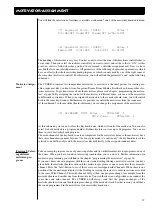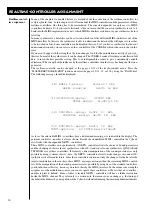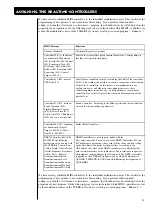
7
With the four "edit" - buttons the four edit menus can be chosen. There are following edit-menus:
[KEY] =
masterkeyboard-edit
[MOT 1] =
motivator 1-edit
[MOT 2] = motivator 2-edit
[SEQ] =
sequencer-edit
As already mentioned at the beginning, the Cyber 6 does not only contain masterkeyboard-functions, but
also two motivators and one sequencer. The masterkeyboard can automatically call on motivator-pro-
grams. They start automatically when playing the keys within the motivator section. If the start of the
motivators is to be avoided, they can be turned off with the "mot. on-off" - key after calling on the
masterkeyboard-program. The motivators are only started when this key is pressed again. With the "seq.
start-stop" - key a sequence can be started or stopped.
These three sliders serve the real time control with the help of midi-controllers. Which midi- controllers
are sent by the sliders is assignable in the masterkeyboard-program. Thus it is possible that there are
different functions on these sliders for every masterkeyboard-program. Besides there three sliders, Cyber
6 contains further freely programmable realtime-controller:
- two wheels in addition to the pitch-bender
- channel aftertouch
- connecting point for a foot-controller and two footswitches
In addition to the sending of midi-controllers these sliders can control motivator and interior sequencer
parameters. The sliders` current data are not being stored in masterkeyboard-programs.
The "snap./copy" - key enables copying the notes created by the arpeggiator into the sequencer backup.
Like a Cyber 6 sequence, a snapshot can be transposed in real time over the keyboard.
Another important data-input device is the keyboard. This is the reason why there is a print above the
keyboard. The white keys are for the punching in letters for naming and together with the "info" - key
midi-channels can be programmed and sub-menus selected (also see description "info" - key). For pro-
gramming rythmic structures in the arpeggiator and sequencer the keyboard contains particular functions.
In this context the first 32 white keys can be used to put in rhythms in the manner of Roland TR 909. This
function will be described in details later.
Basic Operation
Connection
Connect the pedal-jack with a foot-controller. The jack is manufactured as a stereo-handle. The resistance
should be 10 to 50 k ohm. We have made very good experiences with a Yamaha FC-7 foot-controller. Like
the wheels and other Cyber 6 realtime-controller, the function of the foot-controller can be assigned for
every masterkeyboard-programs.
Both footswitch jacks can be connected with footswitches. If the controls are already connected when you
turn the Cyber 6 on, the polarity will automatically be detected. Footswitchers send midi-controllers as
well as sequencer and arpeggiator parameters.•
Summary of Contents for CYBER-6
Page 1: ...1 B E D I E N U N G S H A N D B U C H CYBER 6 The Realtime Enhancer...
Page 2: ...2...
Page 62: ...62 Warranty card...




































